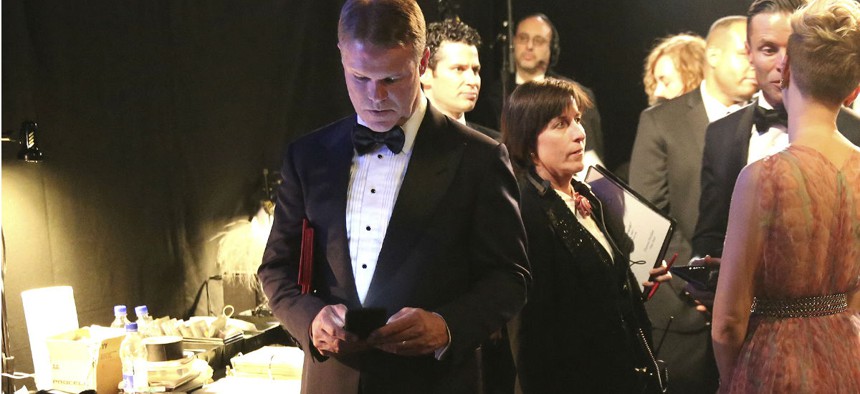
PricewaterhouseCoopers accountant Brian Cullinan, center, holds red envelopes under his arm while using his cell phone backstage at the Oscars. Photo by Matt Sayles/Invision/AP
A World Class Example of Dopamine Derailment
Too much tweeting and picture-taking can ruin your career.
In the latest installment of the story that wouldn’t die, the Academy of Motion Pictures Arts and Sciences has announced that the two Price Waterhouse partners responsible for the Best Picture award snafu will never work the Oscars again.
There’s all kind of evidence that the lead partner, Brian Cullinan, was distracted by Tweeting and snapping photos of Best Actress winner Emma Stone in the very moments that he should have been focused on making sure that Warren Beatty got the right envelope before he went on stage to award Best Picture. Even after Beatty was on stage, if Cullinan had been paying attention to his job instead of to his phone he could have subtly given Beatty the right envelope while the film montage of Best Picture nominees was rolling.
Sadly, for Cullinan and his partners at PwC (and for the La La Land and Moonlight teams), he was focused on his smartphone. I feel bad for Cullinan in a way because what happened to him while he was on the job could happen to any of us while we are on the job. I call it a dopamine derailment.
Here’s how a dopamine derailment works. Dopamine is a neurotransmitter that controls the brain’s pleasure and reward centers. When we find something interesting and exciting, we get a little shot of dopamine in our brain. That feels good, so we keep looking for interesting and exciting things. The cycle then repeats and repeats and repeats. You can easily see how scrolling through Twitter, Facebook or Instagram for interesting things, or better yet, posting interesting things and then seeing if others repost them, can quickly become addictive. There’s a neurological response, the ongoing release of dopamine, that makes it so. Getting jacked up on dopamine may feel good, but it’s not the greatest thing for exhibiting high levels of professional performance. As we’ve learned through the reporting on what happened backstage at the Oscars, Brian Cullinan suffered a dopamine derailment. Too much tweeting and too much picture-taking caused him to lose focus on what he was really there to do.
While you likely won’t be working backstage at the Oscars next year, you are expected to show up focused and perform at your best pretty much every day. With the loaded gun that is your smartphone beckoning you to distraction, how do you avoid a dopamine derailment?
Here are three steps that work:
1. Have a clear picture. Before any given meeting, conversation or assignment ask yourself two questions: What am I trying to do? How do I need to show up to do that?
Visualize your answers to those questions. What happens if you’re completely successful in doing what you’re there to do? What are the outcomes? What are people set up to do? And what are the words or images that describe how you need to show up to enable those outcomes? When you have a clear picture of the outcomes you’re trying to create and how you need to show up to create those outcomes, that mental picture becomes a reference point and a checklist that can help you stay focused during the event.
2. Stay mindful. Once the event starts, stay mindful. By staying mindful, I mean exhibiting two specific qualities that you’re bringing to the moment: awareness and intention. Be aware of what’s going on around you and, equally important, be aware of how you’re reacting or responding to what’s going on around you. That external and internal awareness will help you be intentional about showing up in a way that creates the clear mental picture that you visualized before the event started.
3. Put your phone on airplane mode. This is a super tactical step but also super important. Put your phone on airplane mode and leave it there during the event. By doing so, you remove the temptation and the siren call of checking for things that might seem more interesting than what you’re actually there to do. It’s a guaranteed way to avoid a dopamine derailment.







